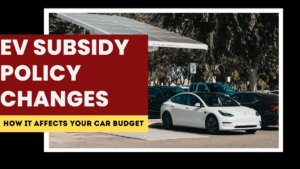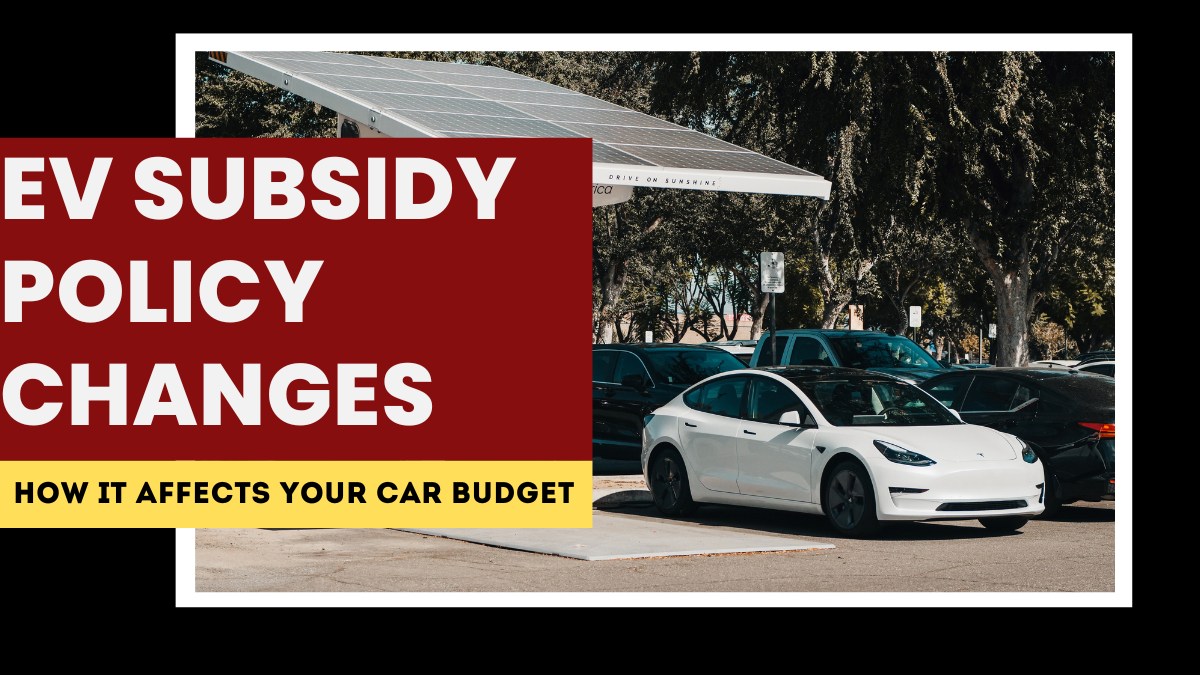Electric vehicles (EVs) are no longer niche in India. By 2025, they have moved into the mainstream, with growing sales across two-wheelers, cars, and commercial fleets. A major factor driving this adoption has been the EV subsidy schemes introduced by the Government of India, particularly under the FAME (Faster Adoption and Manufacturing of Hybrid and Electric Vehicles) program. However, the latest EV subsidy changes 2025 India have altered the benefits available to buyers, and these adjustments will directly impact your car budget. This article breaks down the key FAME policy updates, who stands to benefit, and how the new rules will shape EV affordability in 2025.

Background of EV Subsidies in India
The government launched the FAME scheme in 2015 to accelerate EV adoption. It underwent multiple phases:
-
FAME I (2015–2019): Early support for electric two-wheelers, cars, and buses.
-
FAME II (2019–2024): Focused on large-scale adoption with subsidies for 10 lakh e-two-wheelers, 5 lakh e-rickshaws, and 55,000 electric cars.
-
FAME III (2024–2029): Current phase, expanded focus on personal EVs, fleet vehicles, and nationwide charging infrastructure.
The EV subsidy changes in 2025 fall under the FAME III scheme, which restructured incentives to prioritize affordability and sustainability.
Key EV Subsidy Policy Changes in 2025
1. Reduced Subsidy for High-End EVs
-
Subsidies on cars priced above ₹15 lakh have been cut.
-
Focus shifted to mass-market EVs under ₹12–15 lakh.
-
Luxury EV buyers now receive minimal or no incentives.
2. Extended Benefits for Two-Wheelers and Three-Wheelers
-
Subsidy per kWh of battery capacity for electric scooters reduced slightly but extended till March 2027.
-
E-rickshaws and e-autos continue to get strong incentives to promote clean urban mobility.
3. New Cap on Passenger Car Subsidies
-
Maximum subsidy capped at ₹1.25 lakh per car in 2025.
-
This makes mid-range EVs affordable but reduces benefits for premium models.
4. Charging Infrastructure Support
-
Additional incentives for states setting up fast-charging corridors.
-
Grants for residential and commercial EV charger installations.
5. Incentives for Fleet Buyers
-
Taxis and ride-hailing operators get subsidies for bulk EV purchases.
-
Aimed at replacing high-pollution diesel cabs in metro cities.
Impact on EV Car Buyers in 2025
-
More Affordable Entry-Level EVs: Cars like Tata Tiago EV, Tata Punch EV, and Citroen eC3 remain within reach due to capped subsidies.
-
Higher Cost for Premium EVs: Buyers of models like Hyundai Kona EV or MG ZS EV may feel the pinch as benefits reduce.
-
Boost to CNG and Hybrids: Some buyers may consider hybrid or CNG vehicles if EV incentives no longer match their budgets.
-
Cheaper Charging Setup: Home charger subsidies make long-term ownership costs more attractive.
Impact on EV Manufacturers
-
Tata Motors, Mahindra, and Maruti Suzuki benefit as their focus is on affordable EVs.
-
Luxury brands like Hyundai, MG, and BYD face reduced demand in higher price segments.
-
Manufacturers are investing in smaller battery packs to stay within subsidy limits.
Impact on State Policies
Several states have aligned their EV subsidies with the new central guidelines:
-
Delhi & Maharashtra: Full road tax exemption continues for EVs till 2026.
-
Tamil Nadu & Karnataka: Offer partial subsidies on top of FAME III benefits.
-
Uttar Pradesh & Gujarat: Provide incentives for setting up EV charging hubs.
EV Affordability Comparison 2025
| Model | Price (₹ lakh) | Subsidy 2024 | Subsidy 2025 | Effective Price 2025 |
|---|---|---|---|---|
| Tata Tiago EV | 8 – 10 | ₹1.5 lakh | ₹1.25 lakh | 6.75 – 8.75 |
| Tata Punch EV | 10 – 14.5 | ₹1.5 lakh | ₹1.25 lakh | 8.75 – 13.25 |
| Citroen eC3 | 12 – 14 | ₹1.5 lakh | ₹1.25 lakh | 10.75 – 12.75 |
| Hyundai Kona EV | 23 – 25 | ₹1.5 lakh | ₹0 | 23 – 25 |
| MG ZS EV | 22 – 25 | ₹1.5 lakh | ₹0 | 22 – 25 |
Conclusion
The EV subsidy changes 2025 India represent a strategic shift. The government is focusing on making affordable EVs mainstream, while discouraging subsidies for premium electric cars. For budget-conscious buyers, EVs like the Tata Punch EV, Tiago EV, and Citroen eC3 remain excellent options with attractive incentives. For luxury car buyers, the cost gap between petrol, hybrid, and EV models has widened. Ultimately, the FAME III policy ensures that India’s EV journey moves toward mass adoption, cleaner air, and sustainable transport.
FAQs
What is the maximum subsidy for EV cars in 2025?
The maximum subsidy is capped at ₹1.25 lakh per car under the updated rules.
Are luxury EVs eligible for subsidies in 2025?
No, subsidies for EVs priced above ₹15 lakh have been removed under the new policy.
Do EV two-wheelers still get subsidies in 2025?
Yes, electric scooters and bikes continue to get incentives under FAME III, though slightly reduced compared to earlier.
Are home EV chargers subsidized in 2025?
Yes, buyers get grants for installing home charging units, reducing ownership costs.
Which EVs benefit most from the 2025 subsidy policy?
Mass-market EVs like the Tata Tiago EV, Tata Punch EV, and Citroen eC3 benefit the most, as they fall within subsidy limits.
Click here to know more.
